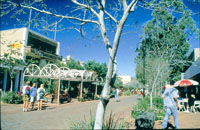|
Araluen Centre for Arts and Entertainment -
Alice Springs Cultural Precinct. The lines
wouldn't meet until 2003. On February 4, 2004, the first
passenger train arrived in Darwin from Adelaide. During
the 1960s it became an important defence location with
the development of the U.S/Australian Pine Gap joint
defence satellite monitoring base, home to about 700
workers from both countries, but by far the major industry
in recent times is tourism. Almost in the exact center
of the continent, Alice Springs is some 1200 km from
the nearest ocean and 1500 km from the nearest major
cities, Darwin and Adelaide. Alice Springs is now the
midpoint of the Adelaide-Darwin Railway.
During World War II, Alice Springs was a staging base,
known as No. 9 Australian Staging Camp, and a depot
base for the long four-day trip to Darwin. The Australian
Army also set up the 109th Australian General Hospital
at Alice Springs. Seven mile aerodrome was also constructed
by the Royal Australian Air Force.
The "Springs" that gave the town its name.
The Arrernte Aboriginal people have made their home
in the Central Australian desert in and around the site
of the future Alice Springs for more than 50,000 years.
The Aboriginal name for Alice Springs is Mparntwe. Three
major groups Western, Eastern and Central Arrernte people
live in Central Australia, their traditional land including
the area of Alice Springs and East/West MacDonnell Ranges.
They are also referred to as Aranda, Arrarnta, Arunta,
and other similar spellings. Their neighbours are the
Southern Arrernte, Luritja, Anmatyerr, Alyawarr and
Western Arrernte peoples. There are five dialects of
the Arrernte language: South-eastern, Central, Northern,
Eastern and North-eastern. Arrernte country is rich
with mountain ranges, waterholes, and gorges; as a result
the Arrernte people set aside 'conservation areas' in
which various species are protected. According to the
Arrernte traditional stories, in the desert surrounding
Alice Springs, the landscape was shaped by caterpillars,
wild dogs, travelling boys, two sisters, euros, and
other ancestral figures.
Alice Springs Desert Park, Sand Drawing Aboriginal.
There are many sites of traditional importance in and
around Alice Springs, such as Anthwerrke (Emily Gap),
Akeyulerre (Billy Goat Hill), Ntaripe (Heavitree Gap),
Atnelkentyarliweke (Anzac Hill), and Alhekulyele (Mt.
Gillen). There are roughly 1,800 speakers of Eastern
and Central Arrernte, making it the largest spoken language
in the Arandic family, and one of the largest speaking
populations of any Australian language. It is taught
in schools, heard in local media and local government.
Many Arrernte people also live in communities outside
of Alice Springs and on outstations. The modern town
of Alice Springs has both western and Aboriginal influences.
The town's focal point, the Todd Mall, hosts a number
of Aboriginal art galleries and community events. Alice
Springs' desert lifestyle has inspired several unique
and interesting events such as the Camel Cup, the Henley-on-Todd
Regatta and the Beanie Festival. The town of Alice Springs
straddles the usually dry Todd River on the northern
side of the MacDonnell Ranges. The region where Alice
Springs is located is known as Central Australia, or
the Red Centre, and is an arid environment consisting
of several different deserts.
In Alice Springs, temperatures can vary by up to 28°C
and rainfall can vary quite dramatically from year to
year. In summer, the average maximum temperature is
in the high 30s, where as in winter the average minimum
temperature can be 7.5C. The annual average rainfall
is 279.2 mm, but in 2001 741 mm fell and in 2002 only
198 mm fell.
|
 |





